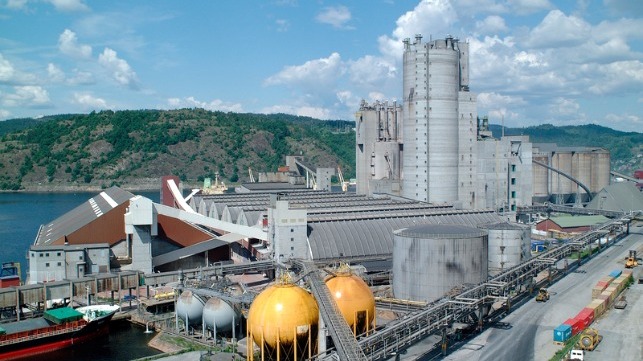Yara’s industrial facility in Porsgrunn wil provide the basis for the green production of ammonia (Yara)
Oslo Norway-Yara International has signed a Letter of Intent with Statkraft, and Aker Horizons, aiming to establish Europe’s first large-scale green ammonia project in Norway, enabling the hydrogen economy and accelerate the green energy transition. The partners will target green hydrogen and green ammonia opportunities within shipping, agriculture and industrial applications, by electrifying Yara’s existing ammonia facility in Porsgrunn.
“This is not just a unique decarbonisation project, but a strategic investment that can establish new value chains for green hydrogen and green ammonia. Yara is a world leader in ammonia, with long experience and leading position within global ammonia production, logistics and trade. With Statkraft and Aker Horizons onboard we gain key expertise within renewable electricity, power markets, industrial development and project execution, giving us a unique opportunity to realize the project,” says Svein Tore Holsether, President and CEO of Yara.
The conversion of Yara’s existing ammonia plant has the potential to become one of the largest climate initiatives in Norway’s industrial history, targeting annual CO2 reductions equivalent to the emissions from more than 300,000 fossil fuel passenger cars. Provided that power is available at the site and the required public co-funding is in place, the project could be realized within 5-7 years.
“Aker has been a driving force for knowledge-based industrial development for 180 years. A partnership with Yara and Statkraft, two fellow Norwegian industrial pioneers, marks the beginning of a new industrial adventure in Norway. The first project in Porsgrunn can be a lighthouse project – providing competitive advantage in a growing global hydrogen economy and building on existing capabilities in the Norwegian supplier industry to create new jobs for the future,” says Øyvind Eriksen, President & CEO of Aker ASA and Chairman of Aker Horizons.
In addition to the Porsgrunn project, the three companies plan to explore the potential for green ammonia production in Northern Norway as a future opportunity.
“Statkraft is Europe’s largest producer of renewable energy. Norway’s rich renewable energy resources are one of our most important competitive advantages. This project paves the way for new industrial development and can at the same time give Norway’s important maritime sector a new competitive advantage, namely access to an efficient and emission-free energy source on a large scale,” says Statkraft CEO Christian Rynning-Tønnesen.
Shipping currently accounts for 2 percent of global GHG emissions, of which long-distance shipping represents 80 percent. Converting all long-distance shipping to ammonia would require approximately 500-600 million tonnes of ammonia annually, 3-4 times the current world production. The Norwegian shipping industry has a stated ambition to reduce emissions from domestic shipping by 50 percent by 2030, which will require significant green hydrogen production.
Yara’s Porsgrunn plant is well set up for large-scale production and export, allowing Norway to quickly play a role in the hydrogen economy. Constructing a new ammonia plant and associated infrastructure is typically a capital-intensive process, but by utilising Yara’s existing ammonia plant and associated infrastructure in Porsgrunn, valued at USD 450 million, the total capital requirement for the project is significantly reduced compared with alternative greenfield locations.
“It is currently more expensive to produce green hydrogen based on renewable electricity and electrolysis than through natural gas, but large-scale production will reduce cost of the electrolysis route. For hydrogen to be exported or used in long-haul shipping or fertilizer production, it needs to be converted to ammonia, and converting Yara’s existing ammonia plant is both faster and more cost-effective than building a new plant. However, realizing this innovative project will require good incentive frameworks and support from the authorities,” says Holsether.
Ammonia’s chemical properties make it ideally suited for the hydrogen economy. It does not need to be refrigerated to the same temperatures as hydrogen, and has a higher energy density than liquid hydrogen, making it more efficient to transport and store. Ammonia is therefore the most promising hydrogen carrier and zero-carbon shipping fuel.
Source: Yara International





